Quite apart from any factual errors, about which I’m not at all qualified to judge, here is what seems to me to be Meyer’s fundamental logical error IMO:
According to Darwin’s theory, the differences in form, or “morphological distance,” between evolving organisms should increase gradually over time as small-scale variations accumulate by natural selection to produce increasingly complex forms and structures (including, eventually, new body plans). In other words, one would expect small-scale differences or diversity among species to precede large-scale morphological disparity among phyla.
(Darwin’s Doubt, Chapter 2)
He illustrates this by asking us to comparing this figure, which he says is what we do see:
With this (appallingly badly drawn) one:
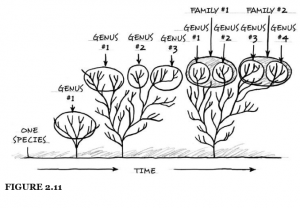 Which he claims Darwin’s theory says we ought to see.
Which he claims Darwin’s theory says we ought to see.
And he says:
The actual pattern in the fossil record, however, contradicts this expectation (compare Fig. 2.12 to Fig 2.11b). Instead of more species eventually leading to more genera, leading to more families, orders, classes and phyla, the fossil record shows representatives of separate phyla appearing first followed by lower-level diversification on those basic themes.
Well, of course it does, Dr Meyer! You have just, in Chapter 2 of your fat book made an absolutely fundamental error of understanding of the entire principle of phylogenetics and taxonomy. No, of course you wouldn’t expect phyla to follow “lower-level diversification on those basic themes”. How could it possibly? And how could you possibly so fundamentally misunderstand the entire point of Darwin’s tree and its relationship to the nested hierarchies observe by Linnaeus?
All branching events, in Darwin’s proposal, whether the resulting lineages end up as different phyla or merely different species, start in the same way, with two populations where there once was one, and a short morphological distance between them. It is perfectly true that the longer both lineages persist for, the greater the morphological distance will become. But that isn’t because they started different, or because the phyla come later. It’s because what we call phyla are groups of organisms with an early common ancestor, whose later descendents have evolved to form a group that has a large morphological distance from contemporary populations who descended from a different early common ancestor.
So when a phylum, or a class, or even a kingdom first diverges from a single population into two lineages, the “morphological distance” from the other lineage will be very short. We only call it a “phylum” because eventually, owning to separate evolution, that distance becomes very large.
I’ve amended the drawings in the book as below, and, instead of labeling the trees by what a contemporary phylogeneticists might have called them, I’ve called each tree a phylum, and I’ve drawn round the organisms that constitute various subdivisions of phyla in colours from orange to green to represent successive branchings. Rather than the little bunch of twigs marked “families” by Meyer, I’ve indicated the entire clade for each subdivision, or tried to.
In Meyer’s version, he called the early sprout “ONE SPECIES”, which a contemporary phylogeneticist (Dr Stephen Chordata perhaps) would have called a “species”. But by the time of the next tree (which I think is supposed to incorporate the first), and Dr Chordata’s distant descendent comes along, she may call it an entire “genus”, and become rather more interested in the “species” that she observes it contains. Move along one to the next tree on Meyer’s time-line and an even more distantly descendent will call the whole tree a “family” containing “genera” and “species”. What was a “genus” to her great^10 grandmother will be several genera to her, and so on. And with each multi-generation of palaeontologist, the descendents of what were close relations in her ancestral palaentologist’s day are now separated by a wide “morphological distance.
So of course, if we look at the fossil record as these speciation-events were happening and try to categorise the organisms in terms of their modern descendents, we will find a great number of different phyla, and far fewer species. Of course they have different body plans, because they lived at a time when many different lineages from the first populations of rather amorphous multi-cell colonies were still around, some with not much symmetry, some with bilateral symmetry, some with five-fold symmetry, and many that didn’t go very far and left no extant lineages. Because of course Meyer also forgets the big extinction events, which are the other part of the answer to why one particular branch “exploded” while the others were never seen again. It’s even in his terrible Figure 1.11. Which he may not have been responsible for drawing, but he should at least have looked at.
ETA: the other drawing, fixed:
Another extraordinary example of Meyer’s complete failure to understand what a clade is, or that the words “phyla” and “class” refer to clades. Coloured emendations are mine (orange/red for Meyer’s “phyla”, blue for Meyer’s “class”):
I’d have expected an urbane, Cambridge-educated guy like Meyer to know the [ETA: spot the erroneous] singular of “phyla” but that’s minor compared to his crashing howler of an attempt to demonstrate what the term means.
ETA:3 Note: As Mung has pointed out, Meyer shows that he does know the singular of “phyla”, he just doesn’t get it correct it in this particular diagram. However, as I have said elsewhere (and above), this error is minor compared with the howler of including only a group of of descendents in his circled “phyla”, not the whole branch, which as I’ve said, undermines his entire argument.

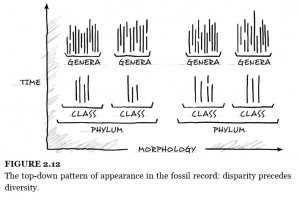
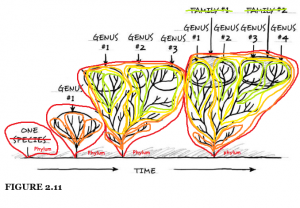
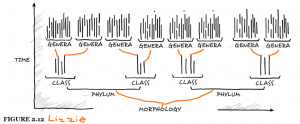
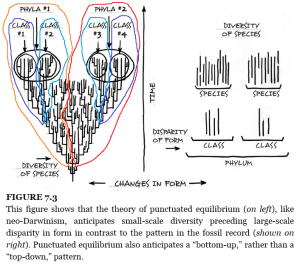
No. The disparity came at the very first organism, when it reproduced – not after the sum of the branching-out process, but at the very beginning, before the branching-out processes.
That organism which (in retrospect) was going to be the founder of what we now call a “phylum” reproduced two near-copies of itself. This was a binary bifurcation. One copy contained a genetic variation (for example, the thinness of cell wall which we now see as gram-negative bacteria) the other a single-mutation’s worth of difference in that one genetic variation (thickness of cell wall, instead). If you had been there at the time, you would probably not have noticed any significance in the bifurcation; it might not have even been named a “speciation” event. But from that one disparity, at the beginning, two phyla originated. Disparity first, then diversity.
We don’t, not even retrospectively, look for a “sufficient accumulation” of diversification and then draw a circle around it, saying this circled group looks like a phylum, and that stuff outside that circle (or in another circle) looks like it must be another phylum.
That’s not even how Linnaeus did his taxonomy and he didn’t have the advantage of genetics and computer models. He did know enough to look for the fundamental, original, bifurcation and work forwards from the ancestral disparity to his families, genera, and species.
He didn’t look at all the animals in the royal circus and say “ooh, there are so many cute furries that they deserve their own group because they’ve diversified so much.
It’s a shame that Meyer doesn’t know as much about taxonomy as even old Linnaeus did. Linnaeus was almost certainly a creationist – everybody was in that time – but he was able to think clearly about the priority of disparity of key characteristic and then the subsequent diversity, if any. Unlike that fool-or-lying-conman Stephen Meyer. That’s why Lizzie was so surprised that Meyer could say something so plain old wrong. It’s been wrong for 300 years.
You do know that some taxa do not contain any diversity, right?
If you have already said what you mean, I apologise. I do not always have time to read every post in a thread. Perhaps you would link to a post where you have detailed exactly what you mean by these terms.
In the mean time I will search the thread.
Searching this thread did not take too long.
Nowhere in this thread do you say what you mean by these terms. You certainly use them, repeatedly, but you do not say what you mean by them.
That was >i>why I asked you to explain how you were distinguishing between them.
Are the “score of posts” that you refer to in some other thread?
If so, please link to one in which you have detailed what you mean, or alternatively, briefly repeat it in this thread.
I must have missed the biology lecture on 500 million year old whale fossils. *facepalm*
ya boo sucks darwinist you makin it all up kind of thing? Good argument!
hotshoe:
Utter nonsense.
Lizzie:
I suspect you are misrepresenting Meyer’s argument. A quote, please?
Elizabeth:
Why. Not. What is it about evolutionary theory that precludes it? Pure improbability? Why is it so improbable?
Is it because, according to Darwinism, diversity precedes disparity, and phyla are so disparate?
petrushka:
And this differs from Meyer’s argument how?
Elizabeth:
A single species diverges. Over time, the differences between that species and other “descendants” of that species might lead to the group being classified as a different family. Over time, the differences might lead to the descendants of that same species being classified as different genera.
How is Meyer saying otherwise!?
Quotes, please.
Meyer:
Exactly.
Elizabeth:
And I’d expect someone what has actually read the book to know better:
“The term phyla (singular phylum)… (p 31)”
Yes, that’s in Chapter 2, a chapter Elizabeth claims to have read.
Why did Meyer get it wrong in his diagram then? Casey “attack gerbil” Luskin was one of Meyer’s primary researchers, wasn’t he? Did the Gerbs screw it up?
Yeah, thorton, jump on that bandwagon, right there along with your illustrious leader who likewise can’t read.
“The term phyla (singular phylum)… (p 31) – Meyer”
She read the word “phyla” that Meyer attached to that drawing of a single phylum well enough. 😀 😀 😀
Do you think Meyer will write a follow-up book explaining the fossil record for the 2 1/2 billion years of life before the Cambrian since he didn’t address it in his “Darwin’s Doubt” ID-Creationist propaganda?
Mung,
I am still waiting for you to explain why we should accept Agassiz’s authority on anything to do with the paleontological record of the Cambrian. Has science acquired more and better data on the fossil record in the 140 years since Agassiz died? YES or NO?
Stupid troll. Answer the bleedin question.
The title of this thread is “Meyer’s Mistake.” The title should be “Liddle’s Mistake.”
The charge that Meyer does not know the difference between the plural (phyla) and the singular (phylum) is clearly false. She can, of course, correct her mistake.
But who cares about the actual facts? Right thorton?
Aardvark:
I’m not a troll. So, answered.
Certainly not Meyer in that wretched piece of IDiot garbage Darwin’s Doubt, since he omitted so many that directly contradict his BS claims.
thorton:
So you’ve read it?
Mung, Is this assertion made by David Warren true:
Could it be that Nick Matzke was correct that the material in the book is principally re-published material and the arguments not all that difficult to anticipate?
Mung, it’s not the descendents that are “classified as a different family”. It’s the entire lineage, right back to the original bifurcation, at which point the two lineages were extremely similar – only differing in the feature that would subsequently characterise the entire family.
And yes, I accept that Meyer knows the difference between the singular and plural of phylum. He just doesn’t get it right on his horrible figures.
Let me express Meyer’s mistake as simply as I can:
Meyer misunderstands the basic relationship between taxonomy and phylogenetics.
He thinks that a higher taxon only embraces a set of contemporaneous organisms, not an entire lineage.
He notes that a set of contemporaneous organisms in a particular taxon will have a greater morphological distance from a set of contemporaneous organisms in a different taxon of the same rank than the members of of each taxon have from each other.
He therefore concludes that higher taxons, marked by disparity appear later than lower taxons, marked by diversity and claims that this is contrary to the prediction of evolutionary theory.
He is wrong, because of his error in understanding what organisms are included within a higher taxon.
The higher taxon begins earlier in time than the lower-ranking taxa, at which point its members will be morphologically closer to those of neighbouring taxa of the same rank. The lower-ranking taxa appear later. This is exactly as you would expect if Common Descent is true.
But Meyer fails to notice this, because he doesn’t realise that his “higher taxa” include all the organisms in the lineage, not just the descendents he is interested in.
This mistake undermines the entire case he attempts to build in his book.
Evolutionary theory does not preclude it; reproductive incompatibility does. That has nothing to do with either diversity or disparity, although there is a pretty good chance that diverse/disparate organisms will be reproductively incompatible.
Meyers implies that something unusual happened in the Cambrian.
Mung, in what chapter and page(s) did Meyer give his ID explanation for the 2 1/2 billion years of life before the Cambrian?
Mung, in what chapter and page(s) did Meyer give his ID explanation for Ordovician major diversification, five mass extinctions and subsequent re-radiations of life after the Cambrian?
What’s that?
He didn’t?
He omitted all those critical facts?
Golly, as a philosopher trying to be a science author he’s pretty incompetent isn’t he?
Mung, it what way was Darwin’s Doubt significantly different that the pseudoscience “mockumentary” film Darwin’s Dilemma about the Cambrian Explosion that Meyer and the DI produced back in 2009?
I actually watched that horrible piece of excrement since it is free on YouTube.
Any new evidence in Doubt? Any new arguments? Or just the same recycled bullshit?
I do not if you Lizzie the reason you are still going on with this.Are unable to say I made a mistake?
No Lizzie, that maybe you can consider it Common Descent but it is not darwinism anymore. It have been noted by Darwin and all the darwinist except the Skeptical darwinists. That is the reason they were desperately looking for the missing fossils or any good explanation for the absence of them. If, as you said, the taxa characteristics were present already in the beginning of the multicellurality then you have no more a tree, you have an orchard model of evolution.
No, According to darwinism you canot say that the common ancestor of Annelida, arthropods and chordata is a an annelida, an arthropod or a chordata. Is just an organism that will evolve in all of them but it still none of them. You need this organism increase diversity to reach the disparity of his descents
This mistake undermines the entire case for darwinism in this site.
The only mistake made was by Lizzie in not comprehending the conceptual case Meyer was making about where novel body plans come from and how we should find links leading up to them in strata, which has nothing whatsoever to do with classification terminology or taxonomic chart rankings.
But then, this is often the problem; Darwinists most often simply cannot understand concepts and rational arguments thereof, but instead cling to terminology and definitions.
Blas – try taking two pencils and putting them on a single point. Then draw 2 lines, at the same approximate rate. Is the point a ‘member’ of the first line, the second line, or both? Get a few friends to help you draw some more branching off your first two. Diversity is steadily increasing. If you nominate the tips of offshoots of the first line as ‘annelids’ and the second ‘chordates’, how far back towards the origin do you think we should go in applying those names? Clearly, we wouldn’t have applied the labels had we been around back then. But we have to make a call, and have monophyletic, paraphyletic and polyphyletic options at our disposal, and the benefit of hindsight.
?
Why is what we call things a problem for ‘darwinism’ (sic)?
I’ve been busily painting the twigs on my apple tree in different colours. When I get to a branching node, I’m stuffed. I’ve gone for stripes. (I’ve had to completely rethink last year’s colour scheme). Yet the tree remains standing, and still grew from a seed.
Given that the earliest examples of divergent body plans would be at or near the species level, you might consider whether you would really expect to find them neatly preserved in strata. Species are rarely so obliging as to be globally common. And the sea floor has been completely turned over about 3 times in the last 500 million years, but for some lumps that have been pasted onto continental plates. Imagine that [insert your favourite species here] are the founders of a brand new dynasty. Would we expect to locate them in 500 million years?
You are hilarious.
If we, as Lizzie does, are talking about taxonomy not until the point where the lines joints because at that point the life form neither follow the definition of chordata nor annelides.
If the point is about diversity and disparity your following sentence is important.
You agree that a paraphyletic and polyphiletic model fits CE then.
Well that is the Meyer points and darwinism problem. You do not have evidence of a tree there and beyond.
The evidence we do have fits Meyer’s argument, not the Darwinist account, which is why you have to come up with “just so” stories that would conveniently hide all of the evidence that would make the Darwinist case.
The irony here is quite irony-meter-exploding, William.
Meyer raises a problem about disparity and diversity based on an erroneous definition of taxa that ceases to be a problem if he uses the definition that his data on disparity and diversity are based on, namely the definition of taxa.
And you say that “Darwinists most often simply cannot understand concepts and rational arguments thereof, but instead cling to terminology and definitions.”
Have you posted a link to your distinction between disparity and diversity yet? Because last time I checked it wasn’t in this thread.
So summarise what you think Meyer’s argument is, William.
Just so stories? So you don’t think strata are lost to magma at subduction zones? You do think it reasonable to find key species neatly represented in exposed strata, despite observation of modern distributions and fossilisation processes? You don’t think genetic commonality is evidence of a real genetic continuum between the organisms?
In denial of these real facts about the planet, perfectly legitimate explanations for ‘missing’ data or evidence of the reality that it is genuinely missing (and not just never-existed), you feel the need to insert magicians. Like I say – hilarious.
To try to put that more succinctly:
Meyer claims that diversity should precede disparity if common descent is true.
He defines disparity as phylum-level differences, and diversity as species-level differences.
Then says that phyla come later than species.
And concludes that disparity follows diversity.
But phyla don’t follow species.
So perhaps Blas or Mung or William would like to justify Meyer’s claim (echoed in his diagrams) that phyla follow species?
Right and true. LUCA of each branch of the tree has to diversify step by step and the differents populations of descents reach the diversity of life.
Lizzie:
He defines disparity as phylum-level differences, and diversity as species-level differences.
You can change the definitions but the problem do not change.
Lizzie:
Then says that phyla come later than species.
True, you have many speciation events between the common ancestor and the first specie that meets the criteria of phyla. Between the first truly chordata and the first truly annelida, if they evolved from a common ancestor shuld be many intermediates forms that weren´t nor chordata nor annelida.
Come on! are you going to deny the need of intermediate forms for darwinism?!
Lizzie:
And concludes that disparity follows diversity.
Right. Is what darwinism require. And Darwin realized it 140 years ago.
Lizzie:
But phyla don’t follow species.
That is what the fossil record of CE shows. Not whay darwinism requires.
Then I look forwards to a formal paper noting as much which can form the basis for a new scientific paradigm now that darwinism has been falsified.
That is what Meyer´s all about. Refuting that explanations for the real (not a mistake) problem that disparity preceded diversity.
Allan Miller:
In denial of these real facts about the planet, perfectly legitimate explanations for ‘missing’ data or evidence of the reality that it is genuinely missing (and not just never-existed), you feel the need to insert magicians. Like I say – hilarious.
Maybe you have to be more skeptical and less believer, nobody talk about magicians.
.
We have to wait until the scientific community abbandon the Lizzie´s denial mode.
Blas:
Struggling to parse that, but I think the issue is one of retrospective relabelling. You can’t call the immediately divided population ‘chordate’ or ‘annelid’ as we would now understand the term, but just call them Species A and Species B. Species A is ancestral to all chordates. Species B is ancestral to all annelids. But only when we get those distinctive morphologies (and subranks within those) do we feel the need to label. And if we are naming the clade (as we should for monophyly), it turns out that humble Species A must be a member of the Annelid clade – despite lacking many distinctively Annelid features.
Is this really that hard? Imagine our languages immediately after their bifurcation from their ancestral proto-Indo-European tongue. That language was neither [your language] nor English. Suppose we wanted to label the entire branch?
Not what I said at all. These are simply the options. The ‘purest’, least arbitrary classification is monophyletic. And there is plenty of evidence that animals are monophyletic.
Genes.
Translation: “we got nothing because real science is too hard!”
Blas, I guarantee that if you actually had some paradigm-shifting idea, there isn’t a scientific publication that would not beg you to present that idea in it. The fact is, you folks do not have anything but erroneous claims and grandiose visions if Meyer’s book is any indication.
Here we go again, are we talking about what we call species and clades or are we talking about diversity and disparity?
If my language an english evolved from a proto-indoeuropean tongue, I would never call english all the intermediates forms between the original tongue and the actual english. But that it is not the point. To prove that my language and english evolved from a primitive tongue you have to found intermediates languages between that primitive tongue and actuals english and my language. You need to find diversity that led to disparity.
Allan Miller:
Not what I said at all. These are simply the options. The ‘purest’, least arbitrary classification is monophyletic. And there is plenty of evidence that animals are monophyletic.
Free to believe, I´m skeptical.
Allan Miller:
Genes.
I bet Meyer´s book talk about this, but if you are right and genes shows a monophiletic tree do not makes Lizzie right.
Hard to tell what you are talking about sometimes. But you mentioned classifications (annelids and chordates) so I focussed on that. For classification to be retroactively applied backwards along converging limbs, it must arrive at points of lesser and lesser diversity (but perhaps not disparity, which just means ‘a great difference’).
So you don’t think that our languages evolved from a common tongue? Despite much unity in the languages classified as ‘proto-indo-european’ – which is rather why they are so classified, and Finnish and Basque regarded as outside? But here’s the kicker: to ‘prove’ that they evolved commonly, I’d have to find languages no-one speaks any more? Otherwise what? God taught our ancestors to speak different variants of ;his’ language?
On what grounds? That’s a few decades of molecular investigation just wafted away then.
I bet it does. And I bet you know he’s right too. Whatever it might be he actually says.
Lizzie? Who’s Lizzie? 🙂 I am arguing on my own account here, you know.
Hard to tell what language Blas speaks, but it isn’t difficult to document the evolution of European languages, since written examples exist for most variants since Roman times.
So yes, we have samples showing the changes in detail.
If there is evidence for genetic continuity (which there is) then it would appear that disparity did not precede diversity, despite the ‘sudden’ appearance of certain body plans in the fossil record. The fossil record is merely one source of data, heavily biased against soft parts and the comparatively rare.
Yes you do. You just don’t realise the sundry powers you have to believe the Designer capable of in order to generate complex replicating forms in one go.
What’s with the sudden appearance of body plans? You start with a simple tube and any change is a new body plan.
No, you don’t. All you have to do is produce better results and people will flock to your cause, for self serving reasons if no other. Simply demonstrate that your ideas are more productive and the rest simply follows!
Diversity preceed disparity as Meyer said.
Allan Miller But here’s the kicker: to ‘prove’ that they evolved commonly, I’d have to find languages no-one speaks any more?
Unique events in the past are unfualsifiable. Then you hve to use historic tools, not science tools. Historic tools are documents and testimonies.
Allan Miller Otherwise what? God taught our ancestors to speak different variants of ;his’ language?
You see, you already discarded an hypothesis only because God do not exists. Not based on any scientific evidence.
Allan Miller On what grounds? That’s a few decades of molecular investigation just wafted away then.
Well you look at the genes describing a monopyiletic tree but you ignore orphans.
Allan Miller “I bet it does. And I bet you know he’s right too. Whatever it might be he actually says.”
No, I do not find ID science.
Allan Miller Lizzie? Who’s Lizzie? I am arguing on my own account here, you know.
This post is about Lizzie claiming Meyer made a mistake, me and other commenter said she is wrong, you supported Lizzie´s claim. If she is wrong, you are wrong. Unless you use darwinistic logic.